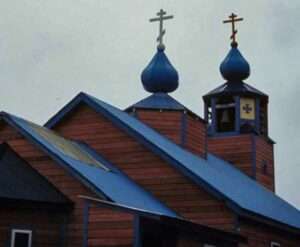
Cross — KRistaaq
Introduced to Kodiak by nineteenth-century Russian Orthodox clergy, the Christian cross is a symbol that appears widely in Alutiiq communities. Although kRistaaq sounds like the word Christ, it comes from the Russian word for cross, kRest, which may be related to the Latin word ‘crux.’ It is not derived from KRistuusaq, the Alutiiq word for Christ, which comes from the Russian khristos and from the Greek khristos, meaning “the anointed one.” Both words are Alutiicized by adding –aq to their final consonant. This is one common way of turning Russian nouns into Alutiiq nouns.
As in other Christian communities, crosses are a common sight in Alutiiq villages, where they decorate homes, mark graves, and grace Orthodox churches. One notable characteristic is their three bars. The top horizontal bar signifies the sign placed above Christ’s head, where the Romans displayed the mocking title “Jesus of Nazareth, King of the Jews.” The second bar, also horizontal, represents the beam on which Christ’s arms were nailed. The third, lower bar is slanted. It represents the footrest that supported Christ’s body.
